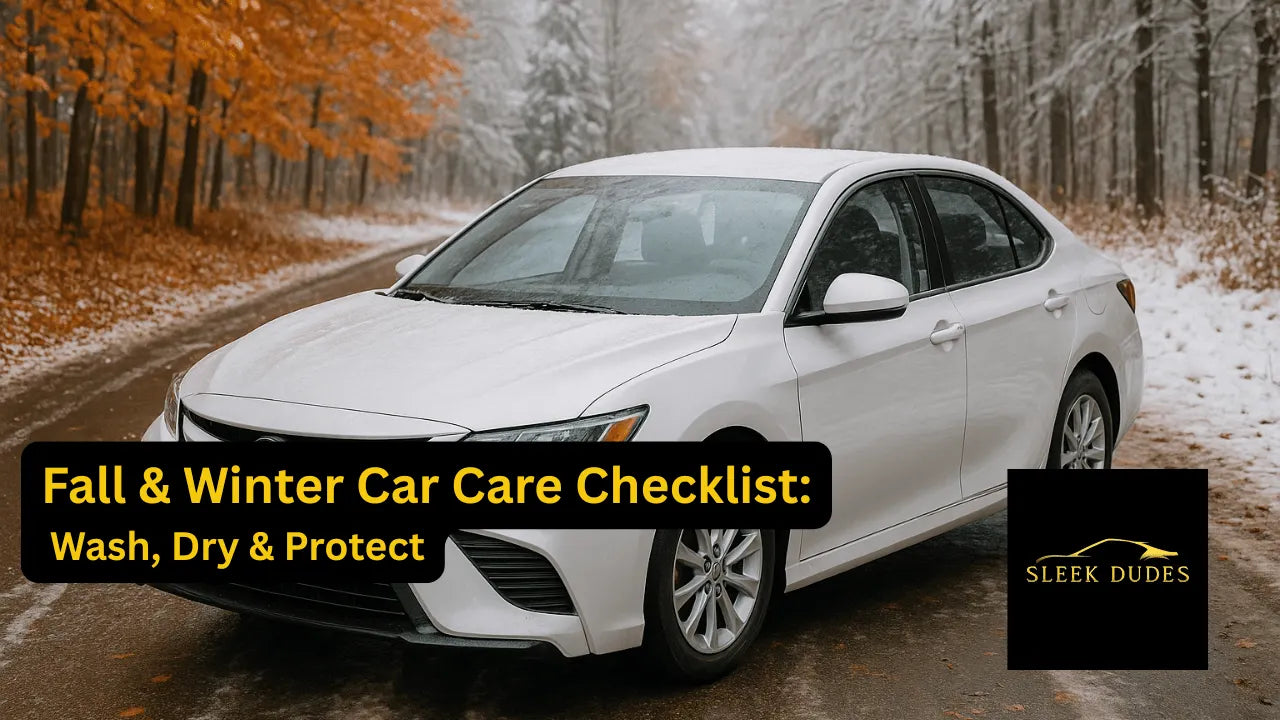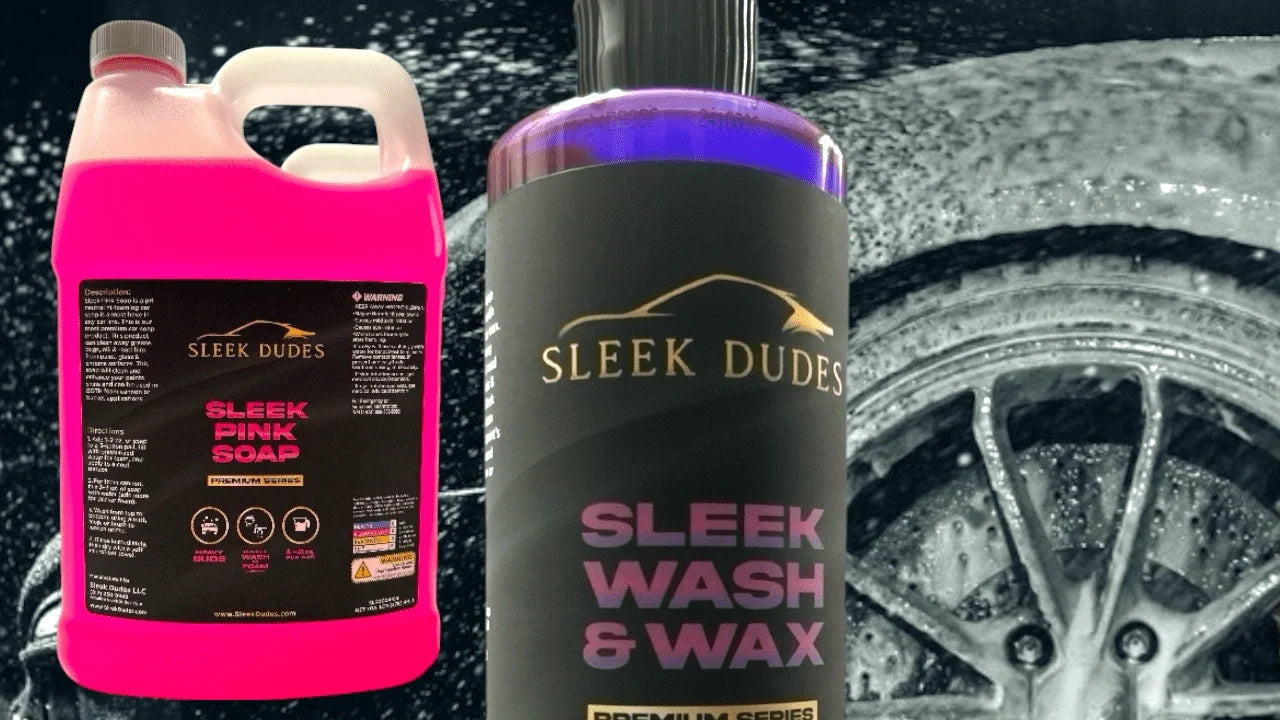Fall & Winter Car Care Checklist: Wash, Dry & Protect
A practical, step-by-step guide to help your car look great and stay protected through cooler temps, wet roads, and road salt—whether you live up North or in milder Southern climates.
When the leaves drop and the first frost shows up, your vehicle faces a new set of challenges. From road salt and slush to chilly rain and shortened wash windows, fall and winter are the toughest seasons on paint, wheels, glass, and interior materials. Without a simple plan, you’ll see faster dulling, stubborn water spots, brake-dust staining, and even early corrosion in problem areas.
The upside: a focused routine—wash, dry, and protect—keeps your car looking sharp and makes every winter cleanup easier. This guide explains why each step matters, exactly how to do it safely, and how often to repeat it so you get real-world results all season. We’ll highlight the role of a pH neutral car wash soap for safe cleaning, a high-quality car drying towel for spot-free results, and a durable ceramic coating spray to lock in protection.
Why Fall & Winter Prep Matters
Cold weather brings more than frost. In snow states, road salt (and liquid de-icers) stick to your paint and wheels, pulling in moisture and accelerating oxidation. In wetter or coastal regions, frequent rain can leave mineral deposits that etch into the clear coat if they’re allowed to sit. Add chilly temps—where leftover rinse water can freeze—and you’ve got the perfect recipe for swirls, spots, and frustration.
- Slow down oxidation & rust: Regular washing with a pH neutral car wash soap plus a hydrophobic top layer disrupt salt and moisture.
- Faster, safer cleaning: Protected surfaces release grime with less scrubbing (which reduces swirls).
- Better visibility: Clean, protected glass sheds water more easily.
- Long-term value: Consistent care preserves appearance and helps maintain resale appeal.
Mild vs. Harsh Winters: What Changes?
Live in the South or a coastal state? Winter prep still matters—just for slightly different reasons. Here’s how to adjust:
Harsh/Snowy Winters
- Focus on frequent washes (every 2–3 weeks) to remove salt using a pH neutral car wash soap.
- Rinse undercarriage often to reduce corrosion risk.
- Use a high-GSM car drying towel to avoid freeze spots.
- Maintain a ceramic coating spray layer to speed up snow/road grime removal.
Mild/Soft Winters
- UV can still fade paint—keep a protective layer with a ceramic coating spray for anti-oxidation support.
- Rainy spells = more water spots—dry thoroughly with a car drying towel after each wash.
- Dust/pollen linger—quick maintenance washes with a pH neutral car wash soap keep the finish slick.
- Cold snaps happen—always dry fully to prevent dawn frost bonding to panels.
The Right Way to Wash (Foundation of Protection)
A safe wash lays the groundwork for winter protection. The goal is to remove abrasive dirt without grinding it into the paint. Using a pH neutral car wash soap gives you cleaning power with lubricity, so you’re less likely to introduce swirls.
- Pre-Rinse: Rinse thoroughly to knock off loose grit, leaves, and salt. This alone reduces a lot of scratching risk.
- Foam Pre-Soak: Blanket the vehicle with a quality pH neutral car wash soap using a foam cannon or foam sprayer. Let it dwell 2–3 minutes to loosen grime.
- Two-Bucket Method: One bucket for soapy water, one for rinsing your mitt. Rinse the mitt often to keep grit out of contact with paint.
- Contact Wash: Top-to-bottom, straight-line motions. Avoid circles; it’s easier to see and correct straight-line marring.
- Final Rinse (Sheeting): Use low pressure to sheet water off panels—this reduces what you have to towel up.
Frequency: In harsh winters, aim for every 2–3 weeks (and especially after driving on salted roads). In milder climates, wash whenever water spots, dust, or pollen build up.
Explore gentle wash options in our Premium Car Wash Soaps.
Why pH-Neutral Soap Matters
Household detergents (like dish soap) are designed to cut grease aggressively, which can strip waxes and dry out plastics and rubber. A pH neutral car wash soap delivers lubrication and cleaning power without tearing down protective layers you want to keep. It’s suitable for coated and uncoated finishes and helps maintain a slick surface that’s easier to dry with a car drying towel.
- Preserves waxes, sealants, and ceramic coatings.
- Helps reduce wash-induced marring thanks to higher lubricity.
- Safe for coated and uncoated finishes alike.
Prefer a little extra shine during maintenance washes? Rotate in a gentle wash-and-wax soap for added slickness between full details.
See our wash options: Car Wash & soap or go directly to Sleek Wash & Wax.
Deep-Clean Wheels & Tires (Salt, Dust & Browning)
Wheels and tires see the worst of winter. Brake dust, road film, and salt can bond tightly and cause staining. Treat them with dedicated tools (don’t mix your paint mitt or towels here):
- Wheel faces & barrels: Use a pH-safe cleaner, plus a wheel brush to reach spokes and inside the barrel.
- Tires: Scrub with a tire cleaner and stiff tire brush until old browning and dressings are removed—fresh rubber looks darker and cleans easier.
- Dressing: Finish with a water-based rubber/plastic/vinyl dressing for a clean, non-greasy look and easier cleanup later.
- Bonus protection: A light pass of a ceramic coating spray on wheel faces helps brake dust rinse away faster in future washes.
Dry Like a Pro (Prevent Spots & Swirls)
Skipping the drying step is a fast way to get water spots—especially where minerals are high or temps drop below freezing. A high-GSM car drying towel absorbs more water with fewer passes and less pressure, which helps reduce swirls. Pairing a slick wash from a pH neutral car wash soap with the right towel gives you the best shot at a spot-free, scratch-free finish.
Technique
- Lay the car drying towel flat and pull gently across panels, blot around mirrors, emblems, and trim.
- Work panel-by-panel so droplets don’t air-dry into mineral spots.
- Flip/fold the towel to expose fresh fibers as you go.
Care & Longevity
- Wash microfiber separately in cold water with a microfiber-safe detergent.
- Avoid fabric softeners (they reduce absorbency).
- Tumble dry low and store clean to keep fibers performing.
Browse our towel lineup: Microfiber Towels.
Lock In Protection with a Ceramic Coating Spray
After the vehicle is fully dry, add a hydrophobic layer with a ceramic coating spray. This thin, slick film helps water, mud, and winter grime release more easily, and it renews that just-washed gloss between deeper details.
- Mist 2–3 sprays per panel onto the surface or your towel.
- Spread evenly with one microfiber towel.
- Buff clear with a second towel for a streak-free finish.
How often? Reapply a ceramic coating spray every 3–4 months (or after heavy weather cycles) to maintain strong beading and slickness. The drier and cleaner the paint when you apply, the better the bond.
See protection options in our Graphene Ceramic Spray or Shine & Save Kits.
Interior Refresh for Cold Months
Winter brings wet mats, foggy glass, and dusty vents. A quick interior reset makes daily driving more comfortable and keeps surfaces from looking tired. Inside the cabin, consistent maintenance pairs nicely with exterior care: clean safely, dry thoroughly where needed, then add protection where it helps most.
- Vacuum carpets and mats regularly to remove salt and grit.
- Wipe plastics & trim with a mild interior cleaner to keep them looking new.
- Clean glass inside and out for safer visibility (especially at night and in rain).
- Dust vents to improve cabin air quality.
Extra Winter Survival Tips
- Washer fluid: Use a winter-grade de-icer and keep an extra bottle in the trunk.
- Glass: A light layer from a ceramic coating spray helps shed water for clearer vision in rain or sleet.
- Door seals: Condition rubber to reduce sticking/freezing.
- Undercarriage: Rinse periodically to reduce corrosion points.
- Drying matters: Even in mild climates, use a car drying towel to eliminate mineral spots before they etch.
- Emergency kit: Pack a scraper, gloves, flashlight, and a compact blanket for roadside comfort.
FAQs: Fall & Winter Car Prep
Do I need to dry before applying a ceramic coating spray?
Yes. Any leftover water can interfere with bonding and may leave streaks. Dry fully with a plush car drying towel, then apply the ceramic coating spray.
How often should I wash in winter?
In snow states, every 2–3 weeks (and after heavily salted drives). In milder climates, wash when you notice spots, dust, or pollen—consistent light maintenance with a pH neutral car wash soap keeps surfaces slick and easy to clean.
What’s the best drying towel for SUVs and trucks?
A large, high-GSM car drying towel provides maximum coverage and absorbs more water with fewer passes—great for big panels and tall glass.
Can I use ceramic spray on wheels and exterior glass?
Most modern sprays are multi-surface safe. A light coat from a ceramic coating spray on wheel faces helps brake dust release; on exterior glass, it can improve water shedding.
How do I care for microfiber towels?
Wash separately in cold water with a microfiber-safe detergent. Avoid fabric softeners, tumble dry low, and store dry. Proper care preserves absorbency and softness.
Is pH-neutral soap enough to remove salt?
Yes for routine maintenance—paired with good technique. The key is consistent washing with a pH neutral car wash soap to avoid long salt dwell times; a protected surface releases residue more easily.
How often should I reapply a ceramic layer?
Every 3–4 months is a practical cadence for strong beading and slickness. Touch up with a ceramic coating spray after severe weather cycles.
What if I don’t have a foam cannon?
No problem. You can still pre-soak panels with a pump sprayer using diluted pH neutral car wash soap, then proceed with a traditional two-bucket wash and dry with a car drying towel.
Disclaimer
Results may vary depending on vehicle condition, application technique, environment, and maintenance habits. Always follow product instructions, consult your vehicle’s care guidelines, and test on an inconspicuous area before full application. Use proper personal protective equipment (PPE) during use.
Sleek Dudes LLC is not liable for damage to vehicles, surfaces, or equipment, or for any injury, health issues, or adverse reactions resulting from misuse, improper application, failure to follow instructions, or failure to use appropriate PPE.
Any resemblance to third-party content is purely coincidental and not intended to infringe upon any intellectual property rights. This content should not be considered professional or manufacturer-specific detailing advice. All applications are at the user’s own discretion.



Leave a comment
All comments are moderated before being published.
This site is protected by hCaptcha and the hCaptcha Privacy Policy and Terms of Service apply.